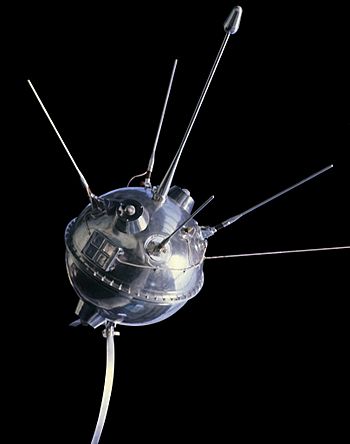Luna 1 facts for kids

A museum replica
|
|
| Mission type | Lunar impactor |
|---|---|
| Operator | Soviet Union |
| Harvard designation | 1959 Mu 1 |
| Mission duration | "Approximately 62 hours" |
| Spacecraft properties | |
| Manufacturer | OKB-1 |
| Launch mass | 361 kilograms (796 lb) |
| Start of mission | |
| Launch date | January 2, 1959 16:41:21 UTC |
| Rocket | Luna 8K72 |
| Launch site | Baikonur 1/5 |
| End of mission | |
| Last contact | "Approximately 62 hours after launch" |
| Orbital parameters | |
| Reference system | Heliocentric |
| Semi-major axis | 1.146 AU |
| Eccentricity | 0.14767 |
| Perihelion | 0.9766 AU |
| Aphelion | 1.315 AU |
| Inclination | 0.01 degrees |
| Period | 450 days |
| Epoch | 1 January 1959, 19:00:00 UTC |
| Lunar flyby (failed impact) | |
| Closest approach | 4 January 1959 |
| Distance | 5,995 kilometres (3,725 mi) |
Luna 1 was a very important space probe launched by the Soviet Union. It was also known by names like the First Cosmic Ship or Cosmic Rocket. Its Russian name, Mechta, means Dream. This mission was the first in the Luna programme. It became the first spacecraft to get very close to the Moon. Luna 1 also made some amazing scientific discoveries. It is seen as one of the greatest achievements of the early Soviet space program.
Spacecraft Design
The Luna 1 spacecraft was shaped like a perfect sphere. From one end, five antennae stuck out. These were used for sending and receiving signals. The surface of the sphere also had special openings for its scientific tools. The spacecraft carried several metal emblems. These showed the Soviet coat of arms.
Scientific Instruments
Luna 1 had special radio equipment. This included a tracking transmitter and a telemetering system. These tools helped it talk to Earth. The spacecraft also carried several scientific devices. These helped scientists learn more about space.
One important tool was a magnetometer. This device was used to measure magnetic fields. It helped scientists understand the magnetic environment around Earth and the Moon. Luna 1 also had a scintillation counter. This tool could detect tiny, high-energy particles in space. Another device was a geiger counter. This measured radiation levels. The spacecraft also carried a micrometeorite detector. This helped find tiny space rocks. All these tools helped gather important data from space.
The Mission
Luna 1 was launched on January 2, 1959. It took off from the Baikonur Cosmodrome. A powerful Luna 8K72 rocket carried it into space. The launch was a big success. Luna 1 became the first object made by humans to reach the speed needed to leave Earth's gravity. This speed is called escape velocity.
On January 3, 1959, something special happened. The spacecraft released a cloud of sodium gas. This gas glowed orange in space. Astronomers on Earth could see it. This helped them track the probe's path. It was also an experiment. Scientists wanted to see how gas behaved in space.
Luna 1 was actually meant to hit the Moon's surface. But on January 4, 1959, it missed its target. It passed about 5,995 kilometers away from the Moon. After this close flyby, Luna 1 did not crash into the Moon. Instead, it began to orbit the Sun. It now travels between the orbits of Earth and Mars. It completes one orbit around the Sun every 450 days. This made Luna 1 the first spacecraft ever to orbit the Sun. It is still orbiting there today.
Images for kids
See also
In Spanish: Mechta para niños



